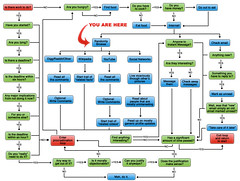Troubleshooting Your Whole Property Management Company
Drew’s Law #2: In property management, nothing is ever as simple as it looks — even when you take this rule into account.
 “Holistic” is a word that has an interesting reputation: either you hear it as a synonym for “snake oil,” or you hear it as a synonym for “comprehensive,” and those two things are really very different. They’re also both very different from the actual meaning of the word, which is related to the word “whole” far more than it is to the word “holy”. To be holistic is to approach a problem by examining the entire set of circumstances and factors — the whole of the situation. So how does this apply to property management?
“Holistic” is a word that has an interesting reputation: either you hear it as a synonym for “snake oil,” or you hear it as a synonym for “comprehensive,” and those two things are really very different. They’re also both very different from the actual meaning of the word, which is related to the word “whole” far more than it is to the word “holy”. To be holistic is to approach a problem by examining the entire set of circumstances and factors — the whole of the situation. So how does this apply to property management?
Simple: a holistic property manager is one who keeps in mind that every aspect of the management process affects every other aspect, and strives to keep all of the bits and pieces balanced and interacting smoothly.
Property Management in Balance…
The general cycle of property management goes like this: you get a property set up to manage, you market it, you get a tenant in, you maintain the landlord-tenant relationship and the property until the lease ends, you perform post-tenant cleanup and maintenance, and you start over at marketing. (Of course, every one of these steps has its own subroutines and so on.) The goal of the cycle is to keep your clients as hands-off as they want to be while maximizing their ROI.
…and Out!
Any hiccup in one of these steps will ultimately effect that ROI, by causing a cascading problem that gets bigger with every cycle. For example, let’s say you have a problem wherein there simply aren’t enough people taking marketing pictures for your properties. That problem won’t necessarily show up in the marketing phase!
Instead, what you might see is that your maintenance budget start to get tighter and tighter month after month. Why?
The slow rate of marketing pictures being taken means that as time passes, more and more properties end up ready to market, but without good marketing pictures, the ads you’re putting out there aren’t attracting the kind of tenants you really want. Instead, they attract the kind of person who is desperate for a place to live and is basically shotgunning applications out to every available property they see.
Most of these people will naturally end up screened out, but some won’t. And those that make it into your properties will (admittedly grossly generalizing here) probably not take care of those properties the same way that a more traditional applicant would. Over the next several months, those tenants will require more maintenance than you have budgeted for, and you’ll have no idea why your maintenance budget is slipping away unless you’re intimately familiar with how each area of your property management company affects each other area.
How to Find the Problem
Fortunately, as esoteric as all that sounds, there’s a fairly straightforward way to find the problem that’s actually sourcing all of your more obvious dilemmas. All you have to do is establish ‘the cycle’ for your business, and then record how long each property spends moving along the pathway from “current tenant gives notice” to “next tenant has moved in.” If there’s a stage that several properties are consistently getting stuck at, that’s where you need to invest in improving. Make sure you have enough people, that the processes you have that are moving properties through the system are efficient and easy to learn, and that you have sufficient redundancy and quality checking. As long as homes are moving step by step along the cycle, with the obvious caveat for genuine disasters and emergencies, you’re doing what you need to be doing.